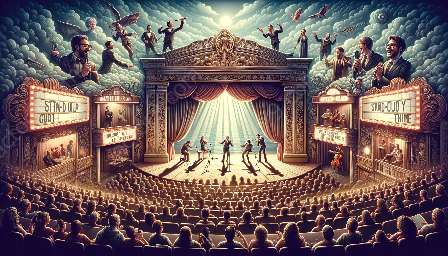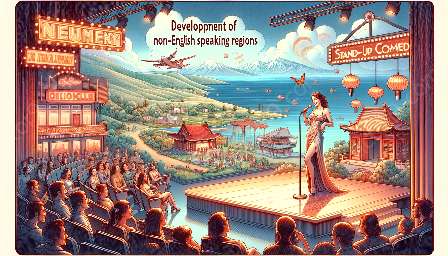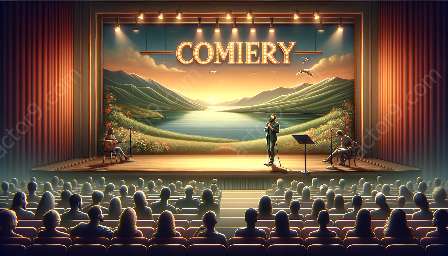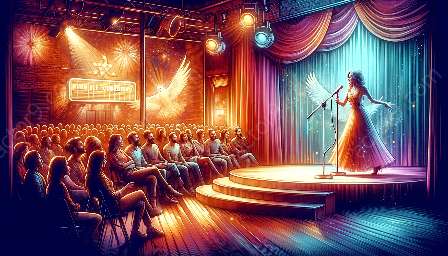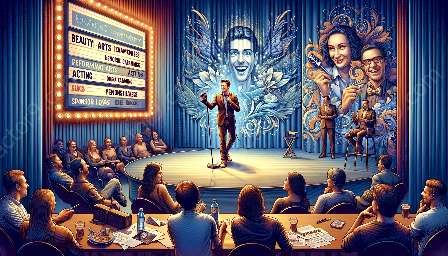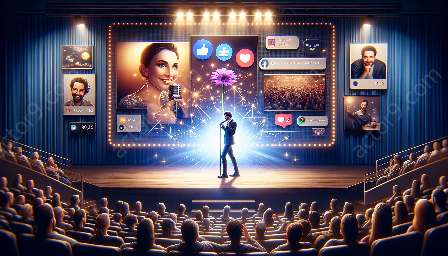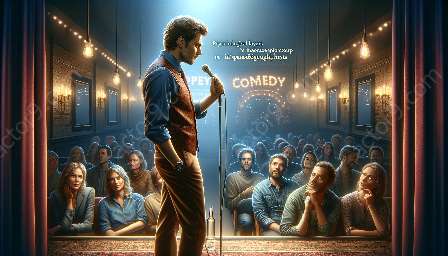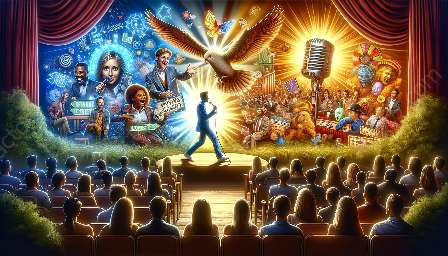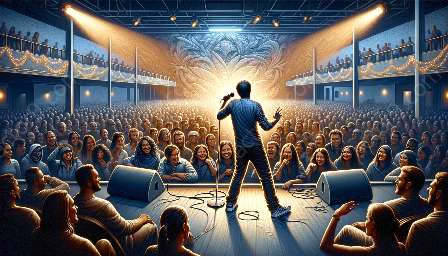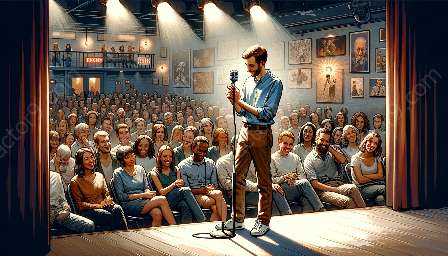Stand-up comedy is an art form that requires comedians to connect with their audience through storytelling, humor, and quick wit. One of the most intriguing aspects of stand-up comedy is the use of improvisation, where comedians create and deliver material on the spot that is compelling, funny, and relatable.
Understanding Improvisation in Stand-Up Comedy
Improvisation in stand-up comedy involves spontaneous, unscripted material that is created in the moment. It requires a deep understanding of comedic timing, audience interaction, and the ability to think on one's feet. Comedians use improvisation to keep their performances fresh, engaging, and relevant to the audience.
The Connection to Performing Arts
Improvisation in stand-up comedy shares a deep connection with the performing arts, especially acting and theater. Both forms of art require performers to convey stories, emotions, and experiences to captivate audiences. In stand-up comedy, improvisation adds an extra layer of excitement and unpredictability, similar to the spontaneity found in live theater performances.
Techniques of Improvisation in Stand-Up Comedy
Comedians utilize various techniques to master the art of improvisation in stand-up comedy. These techniques include:
- Observation and Adaptation: Comedians keenly observe their surroundings, the audience's response, and current events, and adapt their material to create relevant and compelling content.
- Quick Thinking: The ability to think quickly and respond to unexpected situations is essential in improvisational comedy. Comedians use their wit and cleverness to turn unexpected moments into comedic gold.
- Enhanced Audience Interaction: Engaging with the audience in an improvised manner can turn a simple interaction into a hilarious and memorable part of the performance.
- Storytelling: Comedians use improvisation to enhance their storytelling abilities, weaving in unexpected and humorous twists to keep the audience engaged.
The Impact of Improvisation on Stand-Up Comedy
Improvisation injects energy and unpredictability into stand-up comedy performances. It allows comedians to connect with their audience on a deeper level and demonstrates their agility and creativity as entertainers. The element of surprise and delight that comes with improvisation adds a unique dynamic to the art of stand-up comedy.
Conclusion
Understanding the art of improvisation in stand-up comedy provides insight into the thrilling and dynamic nature of this performing art. Comedians who master the skill of improvisation not only entertain but also inspire, leaving audiences in awe of their spontaneous comedic brilliance.
Topic
Understanding the Psychology of Humor and Laughter
View details
Exploring Improvisational Techniques in Stand-Up Comedy
View details
The Role of Satire and Social Commentary in Stand-Up Performance
View details
Developing Authenticity and Vulnerability on Stage as a Comedian
View details
The Intersection of Stand-Up Comedy and Theatrical Performance
View details
The Business and Industry Aspects of a Career in Stand-Up Comedy
View details
Navigating Ethical and Cultural Considerations in Comedic Material
View details
Engaging with the Stand-Up Comedy Community and Creating a Supportive Environment
View details
Incorporating Physicality and Movement for Comedic Impact
View details
Crafting and Delivering Memorable Punchlines and Callbacks
View details
Balancing Spontaneity and Preparation in Stand-Up Comedy
View details
Adapting Material for Diverse Audience Contexts and Cultural Relevance
View details
Handling Hecklers and Unexpected Audience Interactions with Grace and Humor
View details
Leveraging Personal Experiences and Observations for Compelling Comedy
View details
Using Language, Wordplay, and Linguistic Techniques for Comedic Effect
View details
Exploring Comedy in Different Performance Spaces and Contexts
View details
The Integration of Multimedia and Technology in Stand-Up Comedy Performances
View details
Effective Collaboration and Group Dynamics in Creating Comedy
View details
Balancing Humor and Empathy in Addressing Sensitive Topics Onstage
View details
Staying Authentic, Fresh, and Consistent as a Comedic Voice
View details
Cultivating Confidence and Overcoming Performance Anxiety as a Comedian
View details
Adapting to and Leveraging Current Events and Pop Culture References in Comedy
View details
Incorporating Cultural and Social References for Broad Audience Appeal
View details
The Role of Timing, Pacing, and Rhythm in Comedic Delivery
View details
Strategies for Creativity and Freshness in Developing Material
View details
Building and Sustaining Audience Engagement and Connection
View details
Navigating the Role of Gender, Identity, and Intersectionality in Stand-Up Comedy
View details
Incorporating Physical and Vocal Characterizations for Comedic Effect
View details
Leveraging Silence and Pauses for Tension and Anticipation in Comedy
View details
Creating a Memorable and Impactful Stage Persona as a Comedian
View details
Understanding and Navigating the Comedy Industry and Marketplace
View details
Cultivating Resilience and Coping with Setbacks in a Comedy Career
View details
Infusing Personal Style and Voice into Stand-Up Comedy Material
View details
Questions
What are some techniques for making the audience feel engaged during a stand-up comedy performance?
View details
How can performers effectively use timing and pacing to enhance the comedic effect of their material?
View details
What are some common misconceptions about the art of stand-up comedy, and how can they be addressed in a performance?
View details
How can comedians use improvisation to handle unexpected situations or interactions with the audience?
View details
In what ways can stand-up comedians develop their own unique comedic style and voice?
View details
What are the key elements of successful comedic storytelling, and how can they be incorporated into a stand-up routine?
View details
What role does audience interaction and participation play in the success of a stand-up comedy performance?
View details
How can comedians navigate sensitive or controversial topics in their material while maintaining respect and integrity?
View details
What are some effective strategies for dealing with stage fright or performance anxiety as a stand-up comedian?
View details
What are the ethical considerations that stand-up comedians should keep in mind when crafting and delivering their material?
View details
How can comedians effectively handle hecklers or disruptive audience members while maintaining professionalism and humor?
View details
What are the benefits of incorporating physicality and movement into a stand-up comedy performance?
View details
How can comedians effectively use callbacks and call-forwards to create continuity and comedic payoff in their routines?
View details
What are some ways to balance preparation and spontaneity in a stand-up comedy performance?
View details
In what ways can comedians leverage social and cultural references to connect with diverse audience members?
View details
What are some effective techniques for developing and delivering punchlines that resonate with the audience?
View details
How can comedians effectively navigate the use of language and wordplay in their material to enhance humor and impact?
View details
What role does vulnerability and authenticity play in establishing a genuine connection with the audience as a stand-up comedian?
View details
What are the key considerations for adapting and refining material based on audience feedback and performance outcomes?
View details
How can comedians effectively incorporate current events and pop culture references into their comedic material?
View details
What are the potential challenges and benefits of collaborating and creating comedic material in a group or ensemble?
View details
How does the art of improvisation intersect with the structure and preparation involved in crafting a stand-up comedy routine?
View details
What are some effective strategies for using silence and pauses to build tension and comedic anticipation in a performance?
View details
In what ways can comedians leverage their own personal experiences and observations to create relatable and impactful comedic material?
View details
What are some considerations for adapting and tailoring material for different performance contexts, such as open mics, comedy clubs, and theater stages?
View details
How can comedians effectively incorporate physical and vocal characterizations to enhance the comedic impact of their material?
View details
What are the potential advantages and challenges of incorporating multimedia elements into a stand-up comedy performance?
View details
What are some key principles for structuring and pacing a stand-up comedy set to maximize audience engagement and enjoyment?
View details
How can comedians effectively adapt and tailor their material for different cultural and societal contexts while maintaining authenticity?
View details
What are some effective strategies for navigating the business and industry aspects of the stand-up comedy profession, such as bookings, promotions, and networking?
View details
How can comedians effectively engage with and support other performers within the stand-up comedy community, fostering a collaborative and inclusive environment?
View details
What are some effective approaches for balancing humor and empathy in addressing sensitive or thought-provoking topics within a stand-up comedy routine?
View details


